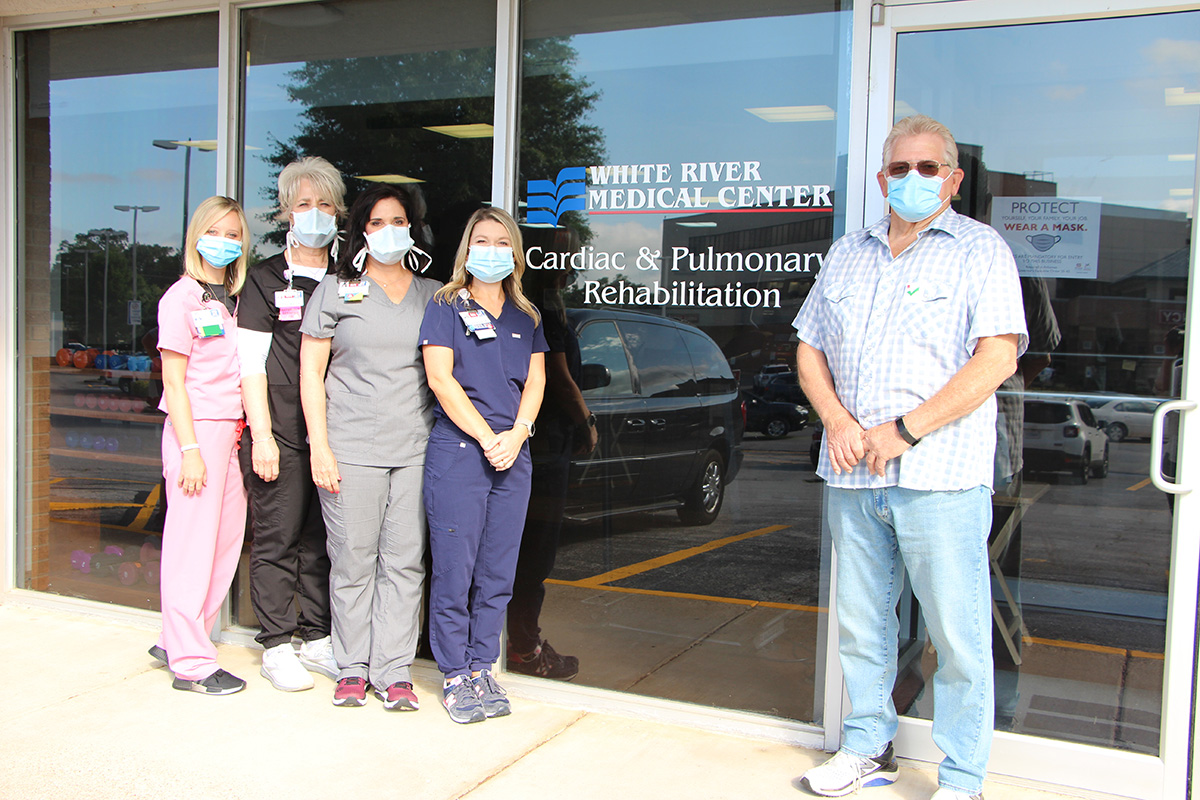WRMC Team Helps Man During Cardiac Emergency
WRMC Team Helps Man During Cardiac Emergency

(Pictured from left to right) Members of the Cardiac Rehab team Heather Mealer, EP; Lavonna Taylor, RN, CCRN; Tamara Stubbs, RN; and Autumn Jones, RN, stand with Randy Sample. When Randy experienced a life-threatening issue with his heart after his exercise at Cardiac Rehab, the team sprang into action to help save his life.
Batesville, AR — When Randy Sample, 65, had a cardiac emergency, he was in the right place at the right time.
His health journey started in March 2021 when Randy told his wife of 41 years, Wahlea, who goes by Lea, he had bad heartburn. With no family history of heart disease, the Floral native seemed to be in near perfect health and had very little reason to suspect his chest discomfort might be anything other than heartburn.
“We tried different heartburn medications and nothing worked,” said Lea.
The next day, Randy felt worsening chest discomfort. He and Lea went to the Pleasant Plains Medical Clinic, an affiliate of White River Health (WRHS). Randy was promptly sent to the emergency room at White River Medical Center (WRMC) in Batesville.
“He was having a heart attack. It was all so unexpected,” said Lea. “We’re talking about a person who seemed to be extremely healthy - never needing so much as a pill for a medical issue - suddenly having very serious health issues. It was devastating.”
Randy underwent a procedure to place a stent into a blocked artery and he worked with his healthcare team to develop a plan to improve his heart health. Cardiac Rehabilitation, a program of structured exercise and education for patients with heart disease was a part of the plan. The three-phase program brings together healthcare professionals to help improve the patient’s quality of life. Benefits of the program include building endurance and providing education for patients in order to help them feel more comfortable exercising on their own once they complete Cardiac Rehab.
“He was going to Cardiac Rehab three times a week. He loved it. He was really coming along,” said Lea.
His exercise plan consisted of 20 minutes on the stationary bike, and 20 minutes on the treadmill. A few weeks into Cardiac Rehab, Randy lost consciousness and collapsed during his cooldown on the treadmill at Cardiac Rehab.
The staff at Cardiac Rehab monitors heart activity as patients exercise. When Randy collapsed, the staff was able to see he went into a life-threatening arrhythmia.
The Cardiac Rehab team members who were working that day, Autumn Jones, RN, Heather Mealer, EP, and Tamara Stubbs, RN, immediately began life-saving Advanced Cardiac Life Support and CPR with Automated External Defibrillator (AED). An AED is a lightweight portable device that delivers an electric shock through the chest in an effort to put the heart back in normal rhythm following sudden cardiac arrest (SCA).
Soon after administering the life-saving care, Randy started opening his eyes. He regained consciousness. Stunning everyone, Randy stood up and got on the gurney with little assistance.
“They say I’m a miracle,” said Randy. “The doctor said they don’t see many who experience an episode like that coming to the ER not needing a ventilator, much less coming to the ER conscious.”
Randy and Lea credit the WRHS staff, especially the quick actions of the Cardiac Rehab team, for Randy’s positive outcome.
“It could have happened anywhere. He was on a boat in the middle of the water just the day before. But it happened with health professionals and across the street from the ER. The team could have panicked and froze, but they acted immediately,” said Lea. “I asked Autumn how she managed to turn Randy over to start CPR since she is so much smaller than he is. She said she didn’t know – she just felt strong. If anything had happened any differently, he wouldn’t have survived. They saved his life.”
Since the episode in Cardiac Rehab, Randy underwent an additional procedure to implant a pacemaker/internal defibrillator. The pacemaker regulates heart rhythms and the internal defibrillator can detect and correct abnormal rhythm.
“Today, I’m doing really well,” said Randy. “I’m looking forward to being cleared to return to the WRMC Cardiac Rehab.”
According to the Centers for Disease Control (CDC), heart disease is the leading cause of death for both women and men in the United States. It’s important to schedule annual wellness exams and screenings, especially for those with a higher risk of heart disease. Talk to your provider or visit heart.org for more information on heart health risks and signs of a heart attack. Visit WhiteRiverHealthSystem.com to find a provider in your area.
